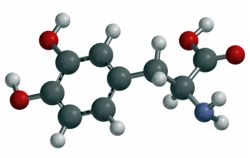Levodopa or drugs which replace dopamine levels
- This can be taken orally in both liquid and tablet form.
- Levodopa is used to increase the levels of dopamine in the brain as dopamine itself is unable to cross the blood-brain barrier and dopamine administered orally to a patient can lead to major effects on blood pressure, and is largely broken down by the body before reaching the brain. Levodopa however, is taken up through the gut and into the central nervous system.
- On entrance into the brain and surviving nerve terminals, Levodopa is metabolised by aromatic L-amino acid decarboxylase (a lyase enzyme which catalyses the carboxylation) to form the active compound dopamine, levodopa therefore acting as a precursor of dopamine. Levodopa therapy hence requires many intact dopaminergic neurons in order to have the desired effect.

-
Levadopa should be administered at low concentrations to start with and gradually increased until the side effects are reported by the individual.
Drugs used in conjunction with L-Dopa:
- Pyridoxine is a likely drug to be administered in conjunction with levodopa due to the need of pyridoxal sulphate in the carboxylation of levodopa to dopamine. However, this conversion can also occur in peripheral tissues before reaching the CNS. It is believed that this could be the reason for some of the side effects experienced from treatment with levodopa.
- Such side effects include nausea, postural hypotension, constipation, vomiting, tiredness, dizziness, insomnia, psychoses, and arrythmias with some effects on learning and sleep patterns and unpredictable dyskinesias in the long term.
- Domperidone can be administered in order to reduce nausea and vomiting symptoms as it is a dopamine antagonist that is unable to cross the blood-brain barrier.
-
Benseradize or carbidopa (DOPA decarboxylase inhibitors which are unable to cross the blood-brain barrier). These prevent levodopa metabolism by the enzyme DOPA decarboxylase which acts in the periphery, and therefore reduce the carboxylation of levodopa to dopamine in the peripheral tissues, working to reduce the side effects of the treatment. Both of the latter drugs can diminish nausea without worsening symptoms of Parkinson’s disease.
Without the use of an inhibitor of the enzyme, levodopa would have to be administered in high doses in order to reach the brain in sufficient concentrations to have an effect on the symptoms of the disease. These high doses would lead to more severe side effects. It is for this reason that levodopa treatment is manufactured together with a dopa decarboxylase inhibitor, for example, Carrbidopa in Sinemet preparations and Benserazide in Madopar preparations of treatment.
- There are many different types of Sinemet and Madopar in order to allow flexibility of treatment of Parkinson's disease, as the different forms contain varying amounts of levodopa, therefore allowing dosage to be tailored to the severity of the case.
- Furthermore, there are controlled release or CR preparations of treatment which were introduced to allow a 'smoother' control of Parkinson's disease, and to aid in nocturnal and early morning symptoms when the drug may have worn off. However, this controlled release option is thought to result in gradual accumulation of levodopa in the body and therefore overdosage can be experienced along with severe dyskinesias.
L-Dopa over time:
- Levodopa initially appears to show vast improvement on the symptoms of Parkinson’s disease in most cases but tends to be less effective over time. This is thought to be due to the loss of dopaminergic nerve cells in the brain increasing with progression of the disease therefore leading to a lack of nerve cells left to absorb the drug. Therefore increasing the drug dosage may be effective in overcoming this, though concentration of dosage appears to be proportional to the severity of the side effects of treatment.
- This can often result in the ‘on’ and ‘off’ oscillations syndrome experienced by patients whereby patients swing from being completely ‘off’ or extremely Parkinsonian to being ‘on’ for example, many movements and abnormal involuntary dyskinetic movements.
-
Furthermore, chronic levodopa administration can lead to more serious side effects such as the development of drug resistence and an end of dose deterioration of function. An individual is likely to experience dyskinesia at peak dose whereby there are unwanted movement of the face and limbs.
-
There are also recent suggestions that levodopa may have a cytotoxic role in the side effects of the treatment, as seen in the rise in cytotoxic markers in rat studies upon use of levodopa. There have been observations of the toxic effects of the treatment resulting in subsequent cell death and it is also being investigated as to whether the administration of L-dopa without the simultaneous giving of serotonin precursors may deplete levels of serotonin which in itself has side effects. For these reasons levodopa administration is limited as far as possible until necessary in individuals.
-
The use of levodopa as a treatment is also limited due to its ability to exacerbate conditions such as cardiac disease, pulmonary disease, diabetes mellitus, glaucoma, melanoma and peptic ulceration all of which can be deadly if mistreated.
Levodopa structural image courtesy of author Sean Ohlinger of Wikimedia Commons.
